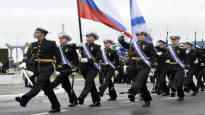Russia wants its military airports on the North Coast and the Arctic Islands to be suitable for the use of bombers. An airport will be opened near Murmansk for amphibious aircraft, a specialty of the Russian armed forces.
Major Evp. Marko Eklund does not see the introduction of a field that has been a quiet life in itself a dramatic matter.
– It is a completely different matter where new machines and actual new performance will arrive in the area. It may be in the throes of a war in Ukraine and export restrictions on Russia. Russia’s military industry is pretty much standing now.
Eklund considers it clear that the reopening of the field is not particularly related to Finland, although it will increase Russia’s capacity to operate close to Finland. In developing the region, Russia aims to strengthen the Northern Fleet and use Arctic resources on Russian terms.
There are plans to renovate two other military airports in Severomorsk, which are still in use. In addition, the fields will be rehabilitated or built by 2030 in Arkhangelsk, Novaya Zemlya, Franz Josef and east of the Siberian coast. In an interview with the news agency TASS, the commander of the northern fleet mentions the goal that all types of aircraft could operate from these fields.
“In practice, this means, among other things, heavy strategic bombers, which will probably be used and displayed as a display of strength,” says Eklund.
The bombers closest to Finland are in Olenogorsk, about 100 kilometers south of Murmansk.
Russia is building aircraft departments
The northern fleet has announced that it intends to open an airport in the Severomorsk region of Safonovo for aircraft that can land in the water. According to military expert Marko Eklund, Russia has more than 30-meter Beriev Be-200 amphibious aircraft that can transport cargo, fire water tanks or more than 70 people.
– They are used for transport to areas that do not have an actual airport. It’s a pretty marginal device, but Russian specialties don’t end there. They have a lot of original solutions.
A more significant solution in terms of power use is the investment in unmanned aerial vehicles. Russia invests a lot in them, as do many other countries.
– Russia is investing in the development of unmanned aerial vehicle divisions based on artificial intelligence, Eklund says.
In addition to precision-equipped aircraft, airplane compartments would include aircraft for reconnaissance and electronic warfare. According to Eklund, in addition to the actual aircraft fleets, small reconnaissance aircraft are already in use by the troops.
However, Western technology bans on technology are expected to significantly slow down the development and deployment of aircraft.
The Arctic has remnants of great power
For years, Russia has been building and rehabilitating military bases in its northern regions and deploying naval and anti-aircraft missiles and radar stations there. Leading researcher at the Foreign Policy Institute Harri Mikkola he also sees the addition of military airports as part of a long continuum that is not yet at its end.
– Russia is trying to maintain its own relative superiority there, that is quite a clear thing. I assume the equipment will continue.
Mikkola states that the Arctic is a region of great strategic importance to Russia, because there are the “remnants of great power” in Russia, ie energy resources and nuclear weapons. The significance of the fact that the Northern Fleet has been granted the status of a military district, which no other fleet has, also denies meaning.
– From a military point of view, Russia is working to secure its nuclear weapons in the North Navy submarines and access to the North Atlantic. They have developed the necessary military infrastructure with great determination.
In recent years, the Nordic countries and NATO have also become more active in the Arctic. For example, NATO’s largest military exercise this year was held in the spring in northern Norway. More than 30,000 soldiers from dozens of countries, including Finland, took part in the Cold Response exercise.
What thoughts did the story provoke? You can participate in the discussion with ID on June 16. until 11 p.m.
